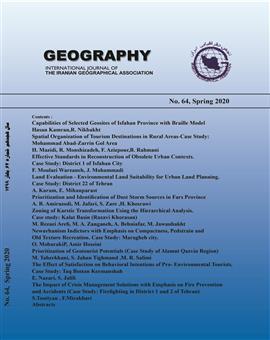Land evaluation - Environmental land suitability for urban land planning (Case Study: District 22 of Tehran)
Subject Areas :amir karam 1 , ensiyeh mihanparast 2
1 -
2 -
Keywords: : urban geomorphology, geology – environmental assessment, urban planning, geographical, geographical information, analytic hierarchy process. Tehran,
Abstract :
Rapid growth of urbanization and increase of population in the recent decades along reactive planning (in sense of urban planning after occurrence of crises and urban challenges, not before occurrence of crises) of urban districts and metropolitan in order to serve desirable services to citizens and the peoples going to cities and extent them, has encountered a problem. In this research , by using the multi criteria techniques and analytic hierarchy process of geo – environmental evaluation for urban land planning with use of geographical information system of zone of 22 has been used .according to this research, effective criteria of land suitability of land planning is divided in to 9 criteria , slop, height , geology , land use , land unit , distance from river, distance from fault , distance from road .the 5 main land uses are high rise building , multistory building , low rise building natural conservation, recreate . the results show that the results show that 19.3 percent area of zone is suitable for high rise building, and 15.28 percent suitable for low rise building. the spatial distribution is of these zones is from north to south and southeast. Suitable area for natural conservation is about 17.6 percent, and 23.33 percent area appropriated for recreation. The conformity of existing building with the suitability maps for the 5 main land uses shows that there are some areas of conformity, but in the other areas, there is unconformity.
bathrellos, G.D. (2007). an overview in urban geology and urban geomorphology. natural geography quarterly, 53-61.
F.C.Daia & C.F.Leeb & X.H.Zhangc. (2001). GIS-based environmental assessment. the first national conference on sustainable development strategies, 6.
houg wood and gun. (1984). The concept of monitoring and evaluation. Elsevier magazine, 220.
houg, J.m. (1993). urban planning and design based on geomorphology. natural geography quarterly, 61.
pares, marc. (2013). urban geography and the production of socio - environmental inegualities. international journal geosciences, 44-52.
pierfrancesco bellini and paolo nesi. (2018). parformance assessment of RDF graph databases for smart city services. journal of visual languages and computing, 28.
Tomlinson and Janwarnken. (2015). comparison ahp fuzzy and ahp in model multi-criteria space decision making for urban planning. the first conference on architecture , land management and sustainnable agriculture, 28-32.
valel.j and campanlla. (2005). crisis of flexible urban settlements. symbolic pulication, 412.
بهرام امینزاده گوهرریزی ،مینا روشن. (1392). سنجش تطبیقی تصویر ذهنی شهروند وشهرساز به مفهوم کیفیت محیط شهری. همایش ملی شهرسازی در گذر زمان, 9.
جعفر میرکتولی و سیدمحمدحسین حسینی. (1393). ارزیابی تناسب اراضی میان بافتی شهر گرگان برای توسعه میان افزا با استفاده ترکیبی از AHP و GIS. فصلنامه علمی - پژوهشی مطالعات شهری دانشگاه کردستان، 69-80.
رجبی, م. (1371). ژئومورفولوژی و شهرها،مطالعه موردی شهربناب(آذربایجان شرقی). نشریه دانشکده ادبیات وعلوم انسانی،دانشکده تبریز, 112.
عزت الله قنواتی وفاطمه گودرزی. (1391). مکانیابی بهینه شهری با تاکید بر پارامترهای طبیعی با استفاده از مدل تلفیقی فازی/AHP. دو فصلنامه ي ژئومورفولوژي كاربردي ايران، 54.
علی اصغر آل شیخ وهمکاران. (2014). برنامهریزی زیست محیطی مناطق صنعتی در شهر اراک. مجله علوم وتکنولوژی محیط زیست, 73-83.
کرم, امیر. (1388). طبقه بندی زمین منظرهای ژئومورفولوژیکی براساس پارامترهای توپوگرافی در محیط GIS. مجله جغرافیا وتوسعه, 8-10.
مسعود مهدوی ومحمد رحمانی. (1391). تحلیلی بر الگوی گسترش کالبدی فضای شهری. نشریه مطالعات محیطی هفت حصار، 29-36.
مهرگان. (1383). پژوهش عملیاتی پیشرفته . انتشارات کتاب دانشگاهی، 170-173.
هادی قنبرزاده وهمکاران. (1387). مکانیابی مناطق بهینه توسعه فیزیکی شهری - مطالعه موردی شهر سبزوار. مجله علوم جغرافیایی واحدمشهد, 152.


